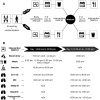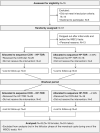A high-protein total diet replacement increases energy expenditure and leads to negative fat balance in healthy, normal-weight adults
- PMID: 33247306
- PMCID: PMC7851826
- DOI: 10.1093/ajcn/nqaa283
A high-protein total diet replacement increases energy expenditure and leads to negative fat balance in healthy, normal-weight adults
Erratum in
-
Corrigendum to: A high-protein total diet replacement increases energy expenditure and leads to negative fat balance in healthy, normal-weight adults. Am J Clin Nutr 2021;113:476-487.Am J Clin Nutr. 2021 Feb 2;113(2):488-489. doi: 10.1093/ajcn/nqaa391. Am J Clin Nutr. 2021. PMID: 33527982 Free PMC article. No abstract available.
Abstract
Background: High-protein diets and total diet replacements are becoming increasingly popular for weight loss; however, further research is needed to elucidate their impact on the mechanisms involved in weight regulation.
Objective: The aim of this inpatient metabolic balance study was to compare the impact of a high-protein total diet replacement (HP-TDR) versus a control diet (CON) on select components of energy metabolism in healthy adults of both sexes.
Methods: The acute intervention was a randomized, controlled, crossover design with participants allocated to 2 isocaloric arms: 1) HP-TDR: 35% carbohydrate, 40% protein, and 25% fat achieved through a nutritional supplement; 2) CON: 55% carbohydrate, 15% protein, and 30% fat. Participants received the prescribed diets for 32 h while inside a whole-body calorimetry unit (WBCU). The first dietary intervention randomly offered in the WBCU was designed to maintain energy balance and the second matched what was offered during the first stay. Energy expenditure, macronutrient oxidation rates and balances, and metabolic blood markers were assessed. Body composition was measured at baseline using DXA.
Results: Forty-three healthy, normal-weight adults (19 females and 24 males) were included. Compared with the CON diet, the HP-TDR produced higher total energy expenditure [(EE) 81 ± 82 kcal/d, P <0.001], protein and fat oxidation rates (38 ± 34 g/d, P <0.001; 8 ± 20 g/d, P = 0.013, respectively), and a lower carbohydrate oxidation rate (-38 ± 43 g/d, P <0.001). Moreover, a HP-TDR led to decreased energy (-112 ± 85 kcal/d; P <0.001), fat (-22 ± 20 g/d; P <0.001), and carbohydrate balances (-69 ± 44 g/d; P <0.001), and increased protein balance (90 ± 32 g/d; P <0.001).
Conclusions: Our primary findings were that a HP-TDR led to higher total EE, increased fat oxidation, and negative fat balance. These results suggest that a HP-TDR may promote fat loss compared with a conventional isocaloric diet. These trials were registered at clinicaltrials.gov as NCT02811276 and NCT03565510.
Keywords: adults; energy metabolism; metabolic biomarkers; protein; total diet replacement.
Copyright © The Author(s) on behalf of the American Society for Nutrition 2020.
Figures




Similar articles
-
A high-protein total diet replacement alters the regulation of food intake and energy homeostasis in healthy, normal-weight adults.Eur J Nutr. 2022 Jun;61(4):1849-1861. doi: 10.1007/s00394-021-02747-1. Epub 2021 Dec 20. Eur J Nutr. 2022. PMID: 34928408 Free PMC article. Clinical Trial.
-
Examining the effects of a high-protein total diet replacement on energy metabolism, metabolic blood markers, and appetite sensations in healthy adults: protocol for two complementary, randomized, controlled, crossover trials.Trials. 2019 Dec 27;20(1):787. doi: 10.1186/s13063-019-3950-y. Trials. 2019. PMID: 31881910 Free PMC article.
-
Energy expenditure and body composition changes after an isocaloric ketogenic diet in overweight and obese men.Am J Clin Nutr. 2016 Aug;104(2):324-33. doi: 10.3945/ajcn.116.133561. Epub 2016 Jul 6. Am J Clin Nutr. 2016. PMID: 27385608 Free PMC article. Clinical Trial.
-
Presence or absence of carbohydrates and the proportion of fat in a high-protein diet affect appetite suppression but not energy expenditure in normal-weight human subjects fed in energy balance.Br J Nutr. 2010 Nov;104(9):1395-405. doi: 10.1017/S0007114510002060. Epub 2010 Jun 22. Br J Nutr. 2010. PMID: 20565999 Clinical Trial.
-
Obesity Energetics: Body Weight Regulation and the Effects of Diet Composition.Gastroenterology. 2017 May;152(7):1718-1727.e3. doi: 10.1053/j.gastro.2017.01.052. Epub 2017 Feb 11. Gastroenterology. 2017. PMID: 28193517 Free PMC article. Review.
Cited by
-
Soda intake influences phenotype, antioxidants and inflammatory status in high protein-fed wistar rats.Heliyon. 2023 Apr 26;9(5):e15781. doi: 10.1016/j.heliyon.2023.e15781. eCollection 2023 May. Heliyon. 2023. PMID: 37180936 Free PMC article.
-
Weight Loss Strategies and the Risk of Skeletal Muscle Mass Loss.Nutrients. 2021 Jul 20;13(7):2473. doi: 10.3390/nu13072473. Nutrients. 2021. PMID: 34371981 Free PMC article. Review.
-
From classical dualistic antagonism to hormone synergy: potential of overlapping action of glucagon, insulin and GLP-1 for the treatment of diabesity.Endocr Connect. 2024 Apr 25;13(5):e230529. doi: 10.1530/EC-23-0529. Print 2024 May 1. Endocr Connect. 2024. PMID: 38579770 Free PMC article. Review.
-
Consumption of a High-Protein Meal Replacement Leads to Higher Fat Oxidation, Suppression of Hunger, and Improved Metabolic Profile After an Exercise Session.Nutrients. 2021 Jan 5;13(1):155. doi: 10.3390/nu13010155. Nutrients. 2021. PMID: 33466462 Free PMC article. Clinical Trial.
-
A high-protein total diet replacement alters the regulation of food intake and energy homeostasis in healthy, normal-weight adults.Eur J Nutr. 2022 Jun;61(4):1849-1861. doi: 10.1007/s00394-021-02747-1. Epub 2021 Dec 20. Eur J Nutr. 2022. PMID: 34928408 Free PMC article. Clinical Trial.
References
-
- Chooi YC, Ding C, Magkos F. The epidemiology of obesity. Metabolism. 2019;92:6–10. - PubMed
-
- McCombie L, Brosnahan N, Ross H, Bell-Higgs A, Govan L, Lean MEJ. Filling the intervention gap: service evaluation of an intensive nonsurgical weight management programme for severe and complex obesity. J Hum Nutr Diet. 2019;32(3):329–37. - PubMed
-
- Lean ME, Leslie WS, Barnes AC, Brosnahan N, Thom G, McCombie L, Peters C, Zhyzhneuskaya S, Al-Mrabeh A, Hollingsworth KGet al. . Primary care-led weight management for remission of type 2 diabetes (DiRECT): an open-label, cluster-randomised trial. Lancet North Am Ed. 2018;391(10120):541–51. - PubMed
Publication types
MeSH terms
Substances
Associated data
LinkOut - more resources
Full Text Sources
Medical
Research Materials
Miscellaneous

